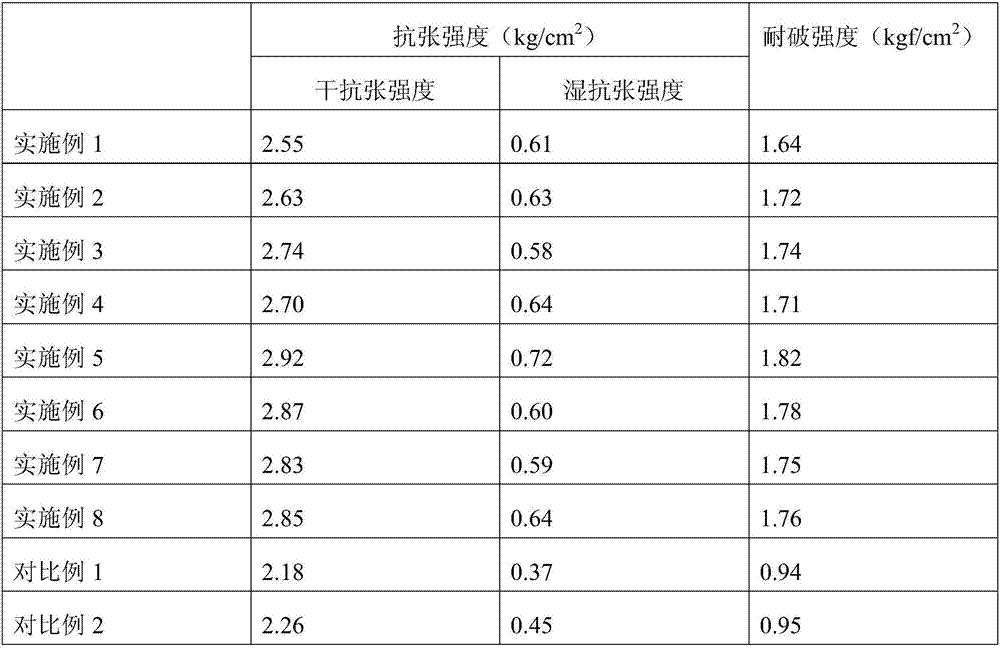Paper pulp
A pulp and wood pulp technology, applied in paper, papermaking, synthetic cellulose/non-cellulose material pulp/paper, etc., can solve the problem of high cost, achieve soft sound quality, improve cohesion, and expand the effect of bandwidth
- Summary
- Abstract
- Description
- Claims
- Application Information
AI Technical Summary
Problems solved by technology
Method used
Image
Examples
Embodiment 1
[0031] A kind of paper pulp, which is mainly formed by mixing and stirring the following raw materials in parts by weight: 45 parts of natural kraft softwood pulp, 15 parts of sisal, 10 parts of cotton pulp, 10 parts of kapok, 0.3 parts of bulletproof fiber, 0.1 part of wool, glass fiber 0.05 parts, 2 parts of direct tan G dye, 1 part of table salt, 3 parts of hydroxyethyl cellulose water repellent, 3 parts of hardener, 3 parts of epoxy resin toughening agent, 3 parts of aluminum sulfate conditioner, polystyrene 0.1 part of sodium sulfonate, 0.1 part of polydimethyldiallyl ammonium chloride and 0.1 part of potassium polymetaphosphate, wherein the hardener is a mixture of monochloroacetic acid and trimethyl phosphate at a ratio of 1:0.2.
Embodiment 2
[0033] A kind of paper pulp, which is mainly formed by mixing and stirring the following raw materials in parts by weight: 65 parts of bleached kraft softwood pulp, 30 parts of sisal, 20 parts of cotton pulp, 20 parts of kapok, 1 part of bulletproof fiber, 0.8 part of wool, glass fiber 0.5 parts, 8 parts of direct tan G dye, 5 parts of table salt, 8 parts of sodium metasilicate waterproofing agent, 8 parts of hardener, 8 parts of phenolic resin toughening agent, 8 parts of aluminum sulfate regulator, polystyrene sulfonic acid 1 part of sodium, 1 part of polydimethyldiallylammonium chloride and 0.5 part of potassium polymetaphosphate, wherein the hardener is a mixture of monochloroacetic acid and trimethyl phosphate at a ratio of 1:0.8.
Embodiment 3
[0035] A kind of paper pulp, which is mainly formed by mixing and stirring the following raw materials in parts by weight: 50 parts of natural kraft softwood pulp, 20 parts of sisal, 12 parts of cotton pulp, 12 parts of kapok, 0.4 part of bulletproof fiber, 0.2 part of wool, glass fiber 0.1 parts, 3 parts of direct tan G dye, 2 parts of table salt, 4 parts of sodium metasilicate waterproofing agent, 4 parts of hardener, 4 parts of unsaturated polyester resin toughening agent, 4 parts of aluminum sulfate regulator, polyphenylene 0.2 parts of sodium ethylene sulfonate, 0.2 parts of polydimethyldiallylammonium chloride and 0.2 parts of potassium polymetaphosphate, wherein the hardener is a mixture of monochloroacetic acid and diethyl oxalate at a ratio of 1:0.2 mixture.
PUM
 Login to View More
Login to View More Abstract
Description
Claims
Application Information
 Login to View More
Login to View More - R&D
- Intellectual Property
- Life Sciences
- Materials
- Tech Scout
- Unparalleled Data Quality
- Higher Quality Content
- 60% Fewer Hallucinations
Browse by: Latest US Patents, China's latest patents, Technical Efficacy Thesaurus, Application Domain, Technology Topic, Popular Technical Reports.
© 2025 PatSnap. All rights reserved.Legal|Privacy policy|Modern Slavery Act Transparency Statement|Sitemap|About US| Contact US: help@patsnap.com

